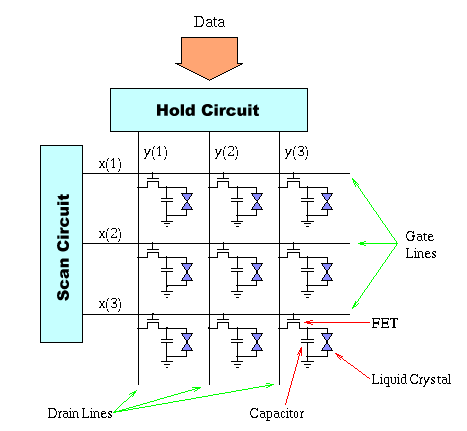Active Matrix LCDs (aka Thin Film Transistor (TFT))

The LCD's themselves have extremely low power requirements.
A very small electric field is required to excite the crystals into their liquid
state. Most of the energy used by an LCD display system is due to the back lighting.
It was mentioned earlier that LCD's slowly transition back to their crystalline
state when the E field is removed. In scanned displays, with a large number
of pixels, the percentage of the time that LCDs are excited is very small. Thus
the crystals spend most of their time in intermediate states, being neither
"On" or "Off". This behavior is indicative of passive displays.
You might notice that these displays are not very sharp and are prone to ghosting.
Another way to building LCD displays uses an active matrix. The individual cells
are very similar to those described above. The main difference is that the electric
field is retained by a capacitor so that the crystal remains in a constant state.
Transistor switches are used to transfer charge into the capacitors during the
scanning process. The capacitors can hold the charge for significantly longer
than the refresh period yielding a crisp display with no shadows. Active displays,
require a working capacitor and transistor for each LCD or pixel element, and
thus, they are more expensive to produce.
TFT displays
Many companies have adopted Thin Film Transistor (TFT)
technology to improve colour screens. In a TFT screen, also known as active
matrix, an extra matrix of transistors is connected to the LCD panel - one transistor
for each colour (RGB) of each pixel. These transistors drive the pixels, eliminating
at a stroke the problems of ghosting and slow response speed that afflict non-TFT
LCDs. The result is screen response times of the order of 25ms, contrast ratios
in the region of 200:1 to 400:1 and brightness values between 200 and 250 cd/m2
(candela per square metre).
The liquid crystal elements of each pixel are arranged so that in their normal
state (with no voltage applied) the light coming through the passive filter
is 'incorrectly' polarised and thus blocked. But when a voltage is applied across
the liquid crystal elements they twist by up to ninety degrees in proportion
to the voltage, changing their polarisation and letting more light through.
The transistors control the degree of twist and hence the intensity of the red,
green and blue elements of each pixel forming the image on the display.
TFT screens can be made much thinner than LCDs, making them lighter, and refresh
rates now approach those of CRTs as the current runs about ten times faster
than on a DSTN screen. VGA screens need 921,000 transistors (640 x 480 x 3),
while a resolution of 1024 x 768 needs 2,359,296 and each has to be perfect.
The complete matrix of transistors has to be produced on a single, expensive
silicon wafer and the presence of more than a couple of impurities means that
the whole wafer must be discarded. This leads to a high wastage rate and is
the main reason for the high price of TFT displays. It’s also the reason
why in any TFT display there are liable to be a couple of defective’ pixels
where the transistors have failed.
There are two phenomenon which define a defective LCD pixel:
A 'lit' pixel, which appears as one or several randomly-placed red, blue and/or
green pixel elements on an all-black background, or
a 'missing' or 'dead' pixel, which appears as a black dot on all-white backgrounds.
The former is the more common and is the result of a transistor occasionally
shorting on, resulting in a permanently 'turned-on' (red, green or blue) pixel.
Unfortunately, fixing the transistor itself is not possible after assembly.
It is possible to disable an offending transistor using a laser. However, this
just creates black dots which would appear on a white background. Permanently
turned on pixels are a fairly common occurrence in LCD manufacturing and LCD
manufacturers set limits - based on user feedback and manufacturing cost data
- as to how many defective pixels are acceptable for a given LCD panel. The
goal in setting these limits is to maintain reasonable product pricing while
minimising the degree of user distraction from defective pixels. For example,
a 1024x768 native resolution panel - containing a total of 2,359,296 (1024x768x3)
pixels - which has 20 defective pixels, would have a pixel defect rate of (20/2,359,296)*100
= 0.0008%.
TFT panels have undergone significant evolution since the days of the early,
Twisted Nematic (TN) technology based panels.